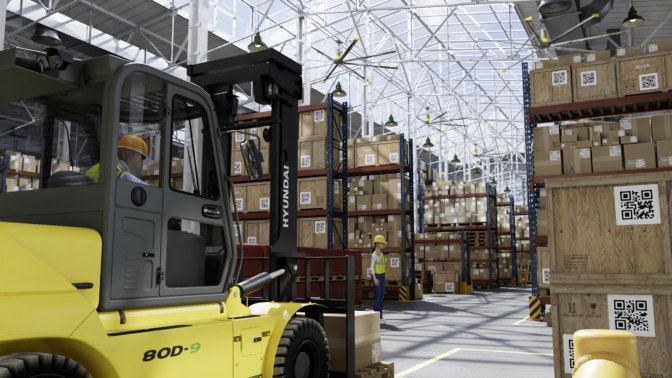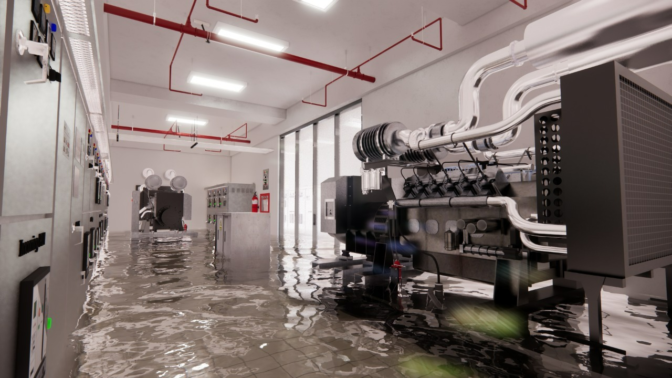Editor’s note: This post is a part of our Meet the Omnivore series, which features individual creators and developers who use NVIDIA Omniverse to accelerate their 3D workflows and create virtual worlds.

Growing up in a military family, Christopher Scott moved more than 30 times, which instilled in him “the ability to be comfortable with, and even motivated by, new environments,” he said.
Today, the environments he explores — and creates — are virtual ones.
As chief technical director for 3D design and visualization services at Infinite-Compute, Scott creates physically accurate virtual environments using familiar architectural products in conjunction with NVIDIA Omniverse Enterprise, a platform for connecting and building custom 3D pipelines.
With a background in leading cutting-edge engineering projects for the U.S. Department of Defense, Scott now creates virtual environments focused on building renovation and visualization for the architecture, engineering, construction and operations (AECO) industry.
These true-to-reality virtual environments — whether of electrical rooms, manufacturing factories, or modern home designs — enable quick, efficient design of products, processes and facilities before bringing them to life in the real world.
They also help companies across AECO and other industries save money, speed project completion and make designs interactive for customers — as will be highlighted at NVIDIA GTC, a global conference on AI and the metaverse, running online Sept. 19-22.
“Physically accurate virtual environments help us deliver client projects faster, while maintaining a high level of quality and performance consistency,” said Scott, who’s now based in Austin, Texas. “The key value we offer clients is the ability to make better decisions with confidence.”

To construct his visualizations, Scott uses Omniverse Create and Omniverse Connectors for several third-party applications: Trimble SketchUp for 3D models for drawing and design; Autodesk Revit for 3D design and 2D annotation of buildings; and Unreal Engine for creating walkthrough simulations and 3D virtual spaces.
In addition, he uses software like Blender for visual effects, motion graphics and animation, and PlantFactory for modeling 3D vegetation, which gives his virtual spaces a lively and natural aesthetic.
Infinite-Compute is a member of NVIDIA Inception, a free, global program that nurtures cutting-edge startups.
Project Speedups With Omniverse
Within just four years, Scott went from handling 50 projects a year to more than 3,500, he said.
Around 80 of his projects each month include lidar-to-point-cloud work, a complex process that involves transforming spatial data into a collection of coordinates for 3D models for manufacturing and design.
Using Omniverse doubles productivity for this demanding workload, he said, as it offers physically accurate photorealism and rendering in real time, as well as live-sync collaboration across users.
“Previously, members of our team functioned as individual islands of productivity,” Scott said. “Omniverse gave us the integrated collaboration we desired to enhance our effectiveness and efficiency.”
At Omniverse’s core is Universal Scene Description — an open-source, extensible 3D framework and common language for creating virtual worlds.
“Omniverse’s USD standard to integrate outputs from multiple software programs allowed our team to collaborate on a source-of-truth project — letting us work across time zones much faster,” said Scott, who further accelerates his workflow by running it on NVIDIA RTX GPUs, including the RTX A6000 on Infinite-Compute’s on-demand cloud infrastructure.

“It became clear very soon after appreciating the depth and breadth of Omniverse that investing in this pipeline was not just enabling me to improve current operations,” he added. “It provides a platform for future growth — for my team members and my organization as a whole.”
While Scott says his work leans more technical than creative, he sees using Omniverse as a way to bridge these two sides of his brain.
“I’d like to think that adopting technologies like Omniverse to deliver cutting-edge solutions that have a meaningful and measurable impact on my clients’ businesses is, in its own way, a creative exercise, and perhaps even a work of art,” he said.
Join In on the Creation
Creators and developers across the world can download NVIDIA Omniverse for free, and enterprise teams can use the platform for their 3D projects.
Hear about NVIDIA’s latest AI breakthroughs powering graphics and virtual worlds at GTC, running online Sept. 19-22. Register free now and attend the top sessions for 3D creators and developers to learn more about how Omniverse can accelerate workflows.
Join the NVIDIA Omniverse User Group to connect with the growing community and see Scott’s work in Omniverse celebrated.
Check out artwork from other “Omnivores” and submit projects in the gallery. Connect your workflows to Omniverse with software from Adobe, Autodesk, Epic Games, Maxon, Reallusion and more.
Follow NVIDIA Omniverse on Instagram, Twitter, YouTube and Medium for additional resources and inspiration. Check out the Omniverse forums, and join our Discord server and Twitch channel to chat with the community.
